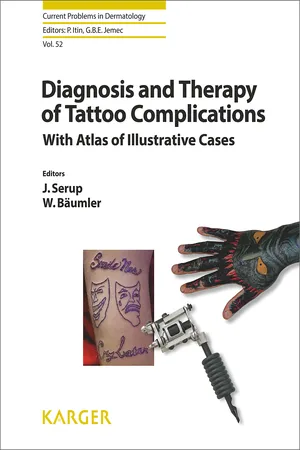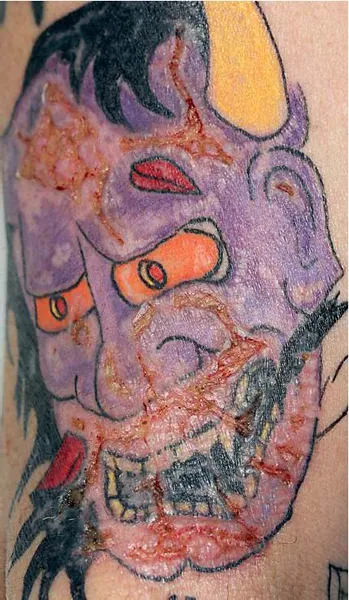
Diagnosis and Therapy of Tattoo Complications
J. Serup, W. Bäumler
- 234 pages
- English
- ePUB (mobile friendly)
- Available on iOS & Android
Diagnosis and Therapy of Tattoo Complications
J. Serup, W. Bäumler
About This Book
Tattooing breaches the skin and can, therefore, cause a variety of complications. This book covers the full spectrum of issues clinical practitioners may encounter when treating affected patients. Introductory chapters include educational information on methods for tattooing, types of tattoos, tattoo inks, and tattoo ink toxicology. The focus is on the diagnosis and classification of tattoo complications. In this regard, a comprehensive atlas of acute and chronic complications serves as a valuable tool. Further chapters summarize available therapies, their rationale, and indication. This includes various medical and surgical treatments with a review of dermatome shaving. Lastly, tattoo removal by gold standard YAG lasers and the more recent pico-second lasers is discussed with the optimal therapeutic outcome in mind.
Frequently asked questions
Information
Index of Cases
145 | Bacterial Tattoo Infection with Staphylococci on the Patient’s Own Skin |
146 | Bacterial Tattoo Infection with Staphylococci from the Tattoo Ink Bottle |
147 | Bacterial Tattoo Infection with a Reused Tattoo Ink Bottle as the Suggested Source of Infection |
148 | Bacterial Tattoo Infection in a Patient with Type 1 Diabetes |
149 | Allergic Reaction in a Red Tattoo: Type Plaque Elevation |
155 | Allergic Reaction in the Red Part of a Multicolored Tattoo: Type Plaque Elevation |
156 | Allergic Reaction in the Bordeaux Part of a Multicolored Amateur Tattoo with Atypical Nodular Appearance |
157 | Allergic Reaction in a Red Tattoo: Type Excessive Hyperkeratosis |
161 | Allergic Reaction in a Red Tattoo: Type Excessive Hyperkeratosis in a Case Predisposed to Hyperkeratotic Response to Physical Stimuli |
162 | Allergic Reaction in a Red Tattoo: Type Excessive Hyperkeratosis, Acneiform Variant with Epidermoid Cysts |
163 | Allergic Reaction in a Red Tattoo: Type Excessive Hyperkeratosis, Acneiform Variant with Epidermoid Inclusions |
164 | Allergic Reaction Provoked by Sun in Two Red Tattoos Made with Different Red Inks |
165 | Allergic Reaction in a Red Tattoo: Type Plaque Elevation with Cross-Sensitivity Reactions in Other Red Tattoos Hitherto Tolerated |
166 | Allergic Reaction in a Red Tattoo Triggering a Cross-Sensitivity Reaction in a Number of Red Tattoos Acquired in the Past |
167 | Allergic Reaction in a Red Tattoo Triggering an Allergic Cross-Reaction in Other Red Tattoos as well as in a Green Tattoo |
168 | Allergic Reaction in a Red Tattoo: Type Excessive Hyperkeratosis-Uncomplicated Dermatome Shaving |
169 | Allergic Reaction in a Red Tattoo: Type Excessive Hyperkeratosis, Acneiform Variant - Dermatome Shaving Followed by Epidermoid Growth and Prolonged Healing |
170 | Aggressive Necrosis in a Multicolored Tattoo with Successive Amputations of the Leg, Chronically Impaired Wound Healing, and Generalized Dermopathy |
172 | Allergic Reaction in a Red Tattoo: Type Ulceronecrotic Reaction, Severe |
173 | Allergic Reaction in a Blue Tattoo Parallel to Spontaneous Color Shift in the Direction of Green |
174 | Allergic Reaction in a Blue Tattoo with Pigment Blowout |
175 | Allergic Reaction in the Lilac Part of a Multicolored Tattoo: Type Plaque Elevation |
176 | Allergic Reaction in a Lilac Tattoo: Type Excessive Hyperkeratosis with Parallel Reaction in Lymph Nodes |
177 | Allergic Eczema in a Cover-Up Tattoo with Progression into the Surrounding Skin |
178 | Generalized Allergic Eczema after a New Tattoo Caused by Primary Sensitization to Nickel |
179 | Generalized Allergic Eczema due to Primary Sensitization by Tattooing: Allergen Not Identified |
180 | Generalized Allergic Eczema the Day after Tattooing due to Preexisting Strong Allergy to Nickel |
181 | Generalized Dermatitis after Sensitization to Parabens from the Tattoo Ink |
182 | Allergic Eczema in a Patient with a Tattoo Reaction and Known Hair Dye Allergy with the Rash Possibly Elicited by a PPD Analogue |
183 | Henna Tattoo Reaction with Generalized Dermatitis: Is PPD Allergy Also a Potential Risk with Permanent Tattooing? |
184 | Reaction in a Black Tattoo:Type Papulonodular Reaction |
185 | Pigment Overload Reaction in a Black Tattoo: Type Papulonodular Reaction Treated with Surgical Excision |
186 | Pigment Overload with Mild Papulonodular Reaction and Sensitivity to Sun |
187 | Pimples after Tattooing with Black Ink |
188 | Black Tattoo with Pigment Blowout |
189 | Black Tattoo with Pigment Blowout to the Surrounding Skin with a Halo Nearby the Tattoo |
190 | Black Tattoo with Pigment Blowout to Underlying Structures, Subcutaneous Inflammation, and Painful Shoulder |
191 | Sarcoidosis Locally in a Black Tattoo with a Papulonodular Reaction |
192 | Sarcoidosis in Black and Brown Tattoos with Erythema Nodosum |
193 | Sarcoidosis in a Black Tattoo Associated with Scar Sarcoidosis and Erythema Nodosum |
194 | Sarcoidosis in Black Tattoos with Enlarged Regional Lymph Nodes and Associated Iridocyclitis |
196 | Sarcoidosis in Black Tattoos Accompanied by Erythema Nodosum, Joint Affection, and Involvement of the Lungs with the Tattoo Reaction as the Clue to Diagnosis |
197 | Sarcoidosis in Black Tattoos Manifested as a Rush Phenomenon |
198 | Sarcoidosis in Black Tattoos Starting Abruptly as a Rush Phenomenon in Every Black Tattoo |
200 | Sarcoidosis in Black Tattoos with Associated Rush Phenomenon in Other Black Tattoos and Affection of the Ankle Joints |
202 | Sarcoidosis in Black Tattoos with Rush Phenomenon and Pulmonary Affection |
204 | Neurosensitive Tattoo Reaction in a Red Tattoo with Constant Itch and Pain |
205 | Neurosensitive Tattoo Reaction Associated with Exercise Addiction Threatening the General Health |
206 | Neurosensory Complaints and Color Change after Bacterial Tattoo Infection |
207 | Neurosensitive Reaction in a Blue Tattoo in a Case with Known Urticaria |
208 | Disturbed Sensitivity and Urticarial Reaction in a Red Tattoo |
209 | Basal Cell Carcinoma in a Tattoo by Coincidence |
210 | Keratoacanthoma(s) in a Tattoo with Spontaneous Recovery |
212 | Paraneoplastic Reaction in a Multicolored Tattoo Provoked by Malignant Lymphoma |
213 | Köbner Provocation of Psoriasis in a Recent Tattoo |
214 | Köbner Provocation of Psoriasis in a Tattoo with a Papulonodular Reaction in Black Pigment Maintaining Local Psoriatic Activity around the Tattoo |
215 | Tattoo Needle Trauma of the Skin Followed by Abnormal Healing of the Tattoo |
216 | Traumatic Tattooing with Severe Local Damage and Chronic Sequels |
218 | Tattoo Inflammation of a Newly Acquired Tattoo from Physicochemical Insult |
219 | Amateur Tattoo of the Oral Mucosa with Unintended Tattooing of the Lip |
220 | Tattoo and Risk of Keloid |
221 | Keloid following Dermatome Shaving on the Chest, a Region Predisposed to Abnormal Scarring |
222 | Laser Removal of a Tattoo Followed by Scarring and Chronic Itch and Pain |
223 | Laser Removal of a Tattoo in an Amateur Setting Causing Laser Burn and a Chronic Papulonodular Reaction |
224 | Laser Removal of a Tattoo with Poor Outcome and Followed by Scarring and Urticaria Factitia in the Treated Field |
225 | Tattoo Removal by Laser with Yellow, Green, and Blue Pigment Resistance to Treatment |
226 | Tattoo Removal by a Caustic Product Causing a Scar |
227 | Caustic Tattoo Removal with Lactic Acid Causing a Scar and Psychological Complications |
228 | Caustic Tattoo Removal with Lactic Acid Followed by a Disfiguring Scar |
229 | Caustic Tattoo Removal with Lactic Acid in a Person Predisposed to Abnormal Scarring |
Bacterial Tattoo Infection with Staphylococci on the Patient’s Own Skin
